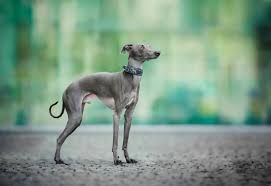
Italian Greyhound
Conditions of detention
Italian Greyhounds thrive in environments where they can be close to their human companions. They are well-suited to both urban and suburban homes but require a safe and secure area for exercise. Due to their thin coat, they prefer warmer climates and need to be kept warm during colder weather.
Useful Fact: Italian Greyhounds are well-suited to apartment living as long as they receive sufficient exercise and attention.
Nutrition and diet
A balanced diet with high-quality dog food is essential for Italian Greyhounds. Their diet should include a mix of proteins, fats, and carbohydrates to support their active lifestyle.
Useful Fact: Due to their small size and fast metabolism, it’s important to feed them small, frequent meals to maintain their energy levels.
Health
Italian Greyhounds are generally healthy, but they can be prone to specific health issues such as dental disease, patellar luxation, and fractures due to their delicate bones. Regular veterinary check-ups are important to monitor their health.
Useful Fact: Regular dental care, including brushing their teeth and providing dental chews, can help prevent dental problems common in small breeds.
Grooming and care
Italian Greyhounds have a short, smooth coat that is easy to care for. Regular brushing helps remove loose hair and keep their coat shiny. Bathing should be done as needed to keep their skin clean and healthy.
Useful Fact: Due to their minimal shedding, Italian Greyhounds are a good choice for people with allergies.
Education and training
Italian Greyhounds are intelligent and eager to please but can be somewhat stubborn. Positive reinforcement techniques work best. Early socialization and consistent training are crucial to ensure they grow into well-mannered adults.
Useful Fact: They excel in obedience and agility training, which can help keep them mentally and physically stimulated.
Toys and entertainment
Interactive toys and activities that stimulate their mind and body are ideal for Italian Greyhounds. They enjoy games that challenge their speed and agility, such as fetch and chasing toys.
Useful Fact: Providing a variety of toys can help keep them entertained and prevent boredom, which can lead to destructive behavior.
Safety
Ensuring a secure environment is important for Italian Greyhounds, especially when they are outdoors. Their strong prey drive can lead them to chase after small animals if not properly contained.
Useful Fact: A secure, fenced yard is essential to keep them safe and prevent them from running off.
Accessories
Italian Greyhounds benefit from durable collars, leashes, and harnesses designed for small dogs. Proper identification tags and microchips are also important.
Useful Fact: Due to their thin coat, they may need sweaters or jackets during colder weather to keep them warm.
Socialization
Early and consistent socialization helps Italian Greyhounds become well-adjusted dogs. Exposing them to various people, animals, and environments from a young age is beneficial.
Useful Fact: Puppy classes and regular social outings can enhance their social skills and reduce timidity or shyness.
Travel and Transportation
Italian Greyhounds travel well if accustomed to it from a young age. They should be secured in a crate or with a seatbelt harness during travel.
Useful Fact: Their small size makes them easy to transport, and they often enjoy being close to their owners during trips.
Behavior and psychology
Italian Greyhounds are known for their affectionate, playful, and gentle nature. They form strong bonds with their families and are generally good with children and other pets. They can be reserved with strangers but are usually not aggressive.
Useful Fact: Providing regular mental and physical stimulation helps maintain their positive behavior and overall well-being. Their affectionate nature makes them excellent companions.
Legal aspects
There are no specific legal aspects concerning Italian Greyhounds, but local regulations regarding pet ownership should be followed. Ensuring they are registered and microchipped is important.
Useful Fact: Being aware of local leash laws and breed-specific legislation is important for responsible ownership. Registration and identification help in case they get lost.


